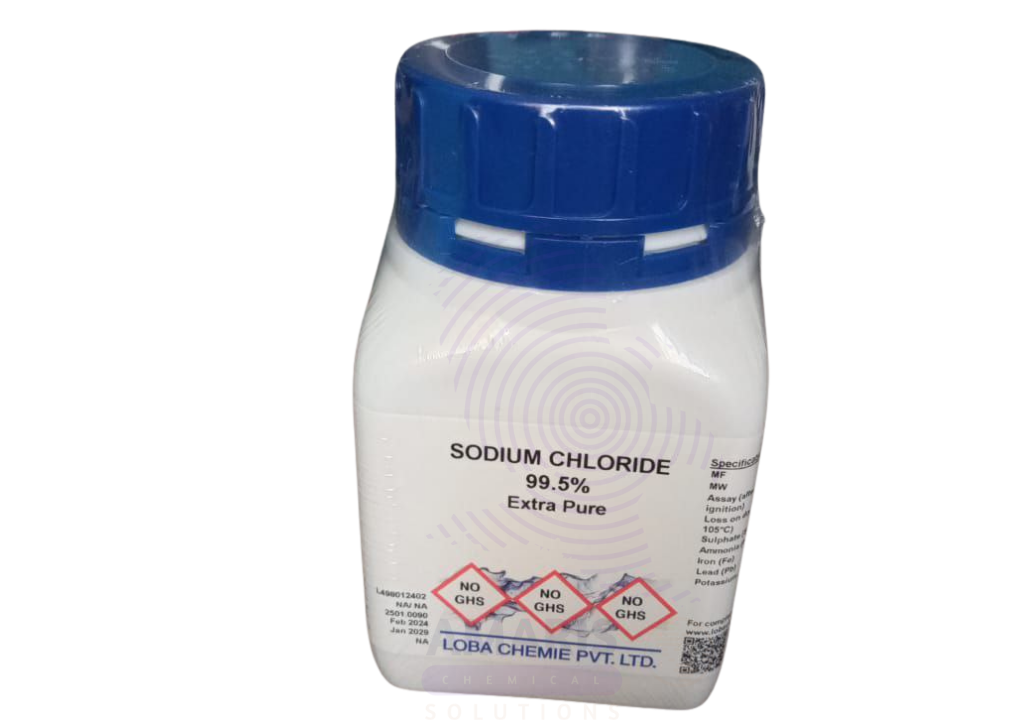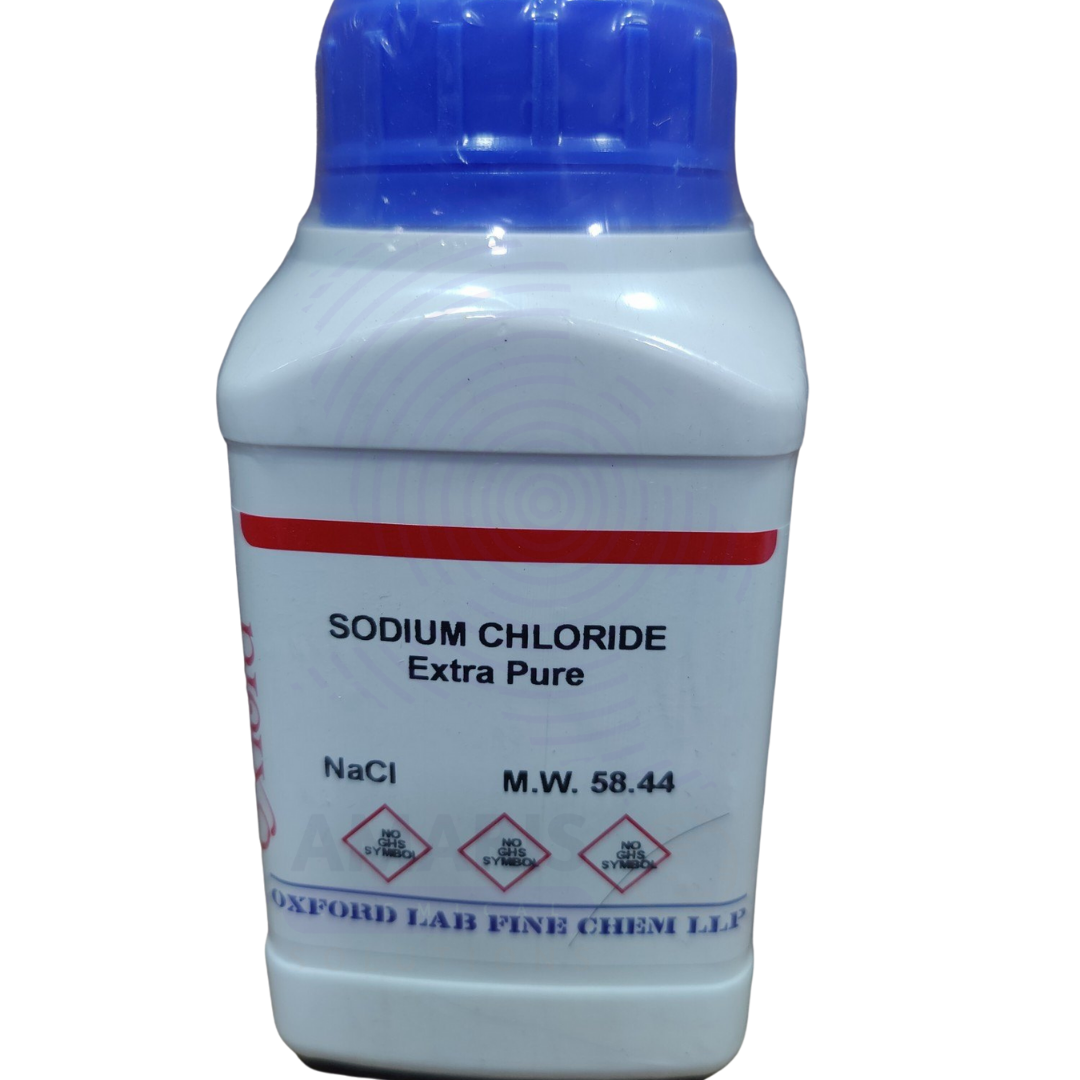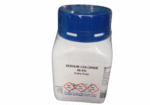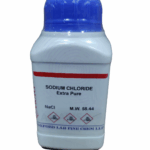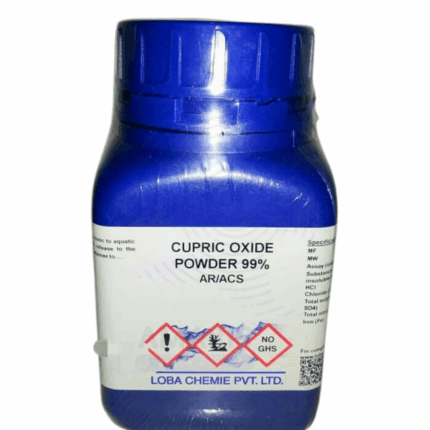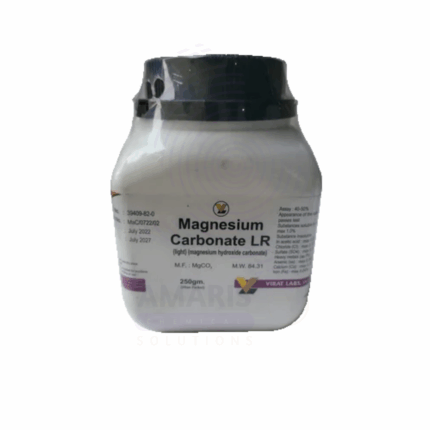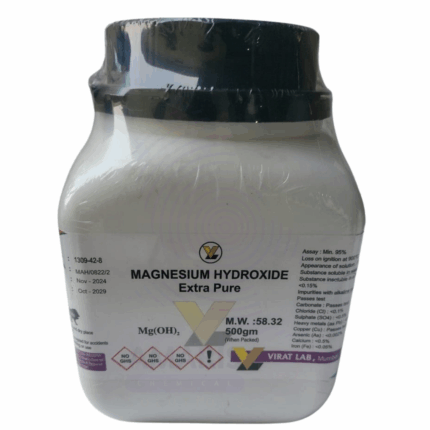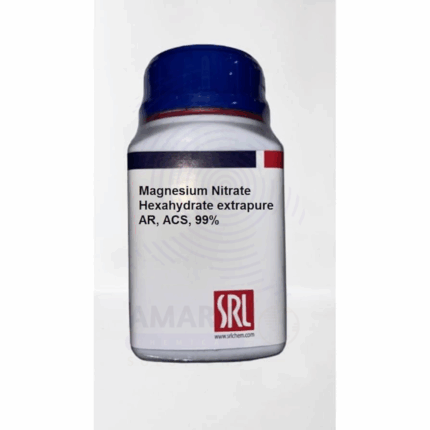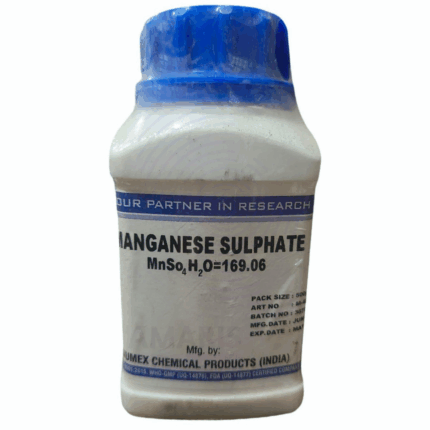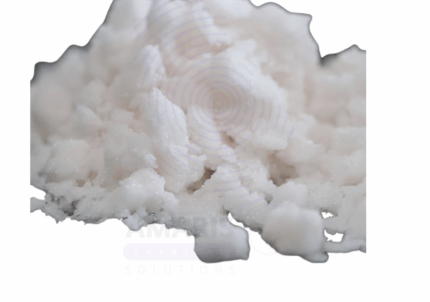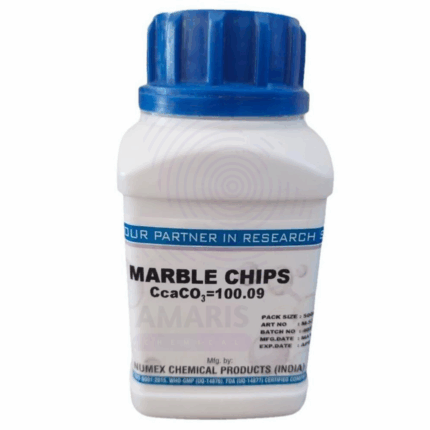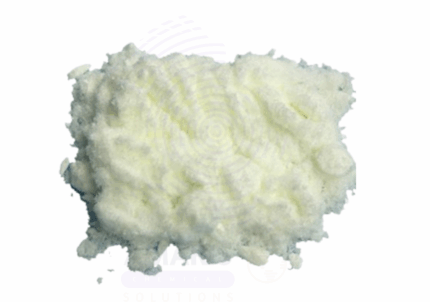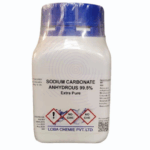
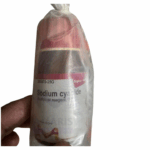
Sodium Chloride Extra Pure
$ 18.20
Sodium Chloride Extra Pure is a high-purity, white crystalline compound commonly used in laboratory, pharmaceutical, food, and chemical applications. It serves as a fundamental reagent and electrolyte in analytical chemistry and clinical formulations. With exceptional stability and water solubility, sodium chloride is indispensable in various industries ranging from medical saline production to food preservation. Its Extra Pure grade ensures consistent results for high-precision work.
Sodium Chloride Extra Pure
PRIMARY USES
- Analytical Reagent & Laboratory Applications:
Used as a reagent for calibration and preparation of standard solutions
• Acts as an ionic strength adjuster in chemical and biochemical assays
• Serves as a medium for conductivity measurements and osmotic pressure studies - Pharmaceutical & Medical Industry:
Used in saline solutions for injections, IV fluids, and wound irrigation
• Component in oral rehydration salts (ORS) and electrolyte formulations
• Acts as an excipient in tablets and capsules - Food Industry (regulated grade):
Used as a seasoning, preservative, and curing agent
• Essential in food preservation methods like pickling and brining
• Functions as a carrier for micronutrients and flavor enhancers
SECONDARY USES
- Chemical Manufacturing:
Feedstock in the chlor-alkali process to produce sodium hydroxide and chlorine
• Intermediate in production of sodium salts and other inorganic compounds - Water Treatment:
Used in water softening systems to regenerate ion exchange resins
• Helps remove hardness ions (calcium and magnesium) from water - Cosmetic & Personal Care Products:
Used in bath salts, scrubs, toothpaste, and skin cleansers
• Acts as a thickening agent and viscosity modifier in cosmetic formulations - Textile & Dyeing Industry:
Enhances dye absorption and fixation in cotton dyeing processes
• Acts as an electrolyte to control dye solubility and uniformity
1. Basic Identification Attributes
- Chemical Name: Sodium Chloride
• CAS Number: 7647-14-5
• HS Code: 2501.00.10
• Molecular Formula: NaCl
• Synonyms:
- Table salt
- Rock salt
- Common salt
- Halite
2. Physical & Chemical Properties
Physical State: Crystalline solid or granules
• Color & Odor: White, odorless
• Melting Point: ~801 °C
• Boiling Point: ~1413 °C
• Density/Specific Gravity: ~2.17 g/cm³
• Solubility:
- Highly soluble in water (~359 g/L at 25 °C)
- Slightly soluble in glycerol and insoluble in ethanol
• pH Level: Neutral (pH ~6.7–7.3 for 0.9% solution)
• Vapor Pressure & Volatility: Not volatile
• Flash Point: Not applicable
• Autoignition Temperature: Not applicable
• Viscosity: Not applicable
3. Safety & Hazard Attributes
Hazard Class (GHS Classification):
- Not classified as hazardous
- May cause eye or skin irritation in high concentrations or prolonged exposure
• NFPA Ratings: - Health: 0
- Flammability: 0
- Reactivity: 0
• Exposure Limits: - No OSHA PEL or ACGIH TLV specified
• Reactivity: - Stable under normal conditions
- Reacts with strong acids to produce hydrogen chloride gas
4. Storage & Handling Attributes
Storage Conditions:
- Store in a dry, cool, and well-ventilated area
- Keep container tightly closed to prevent caking or contamination
• Incompatible Materials: - Strong acids
- Strong oxidizing agents
• Container Type: - Plastic or sealed metal containers
• Shelf Life & Expiration Date: - Indefinite if stored properly and kept dry
• Special Handling Requirements: - Use basic PPE like gloves and goggles in bulk handling
- Minimize dust generation during transfer
5. Regulatory & Compliance Attributes
Regulatory Status:
- Approved for use in food and pharmaceuticals (FCC, USP, BP)
- Listed in REACH, OSHA, and EPA inventories
• Transportation Restrictions: - Not regulated as a hazardous material
• Waste Disposal Method: - Dispose in accordance with local regulations
- Classified as non-hazardous waste
6. Environmental & Health Impact
Ecotoxicity:
- Can be harmful to freshwater ecosystems in excessive concentrations
• Persistence in Environment: - Dissolves readily in water; naturally occurring compound
• Carcinogenicity/Mutagenicity: - Not classified as carcinogenic or mutagenic
• Biodegradability: - Inorganic; not biodegradable but environmentally stable
SAFETY PRECAUTIONS
Personal Protective Equipment (PPE):
• Wear protective gloves and safety goggles if handling large quantities
• Use dust mask or respirator in case of airborne dust
• Wear protective clothing or lab coat
Handling:
• Handle in a well-ventilated area
• Avoid creating dust
• Avoid contact with eyes and prolonged skin exposure
• Wash hands thoroughly after handling
Storage:
• Store in tightly sealed container
• Keep away from moisture and incompatible substances
FIRST AID MEASURES
Inhalation:
• Move to fresh air
• Seek medical attention if irritation occurs
Skin Contact:
• Wash with soap and water
• Remove contaminated clothing
• Seek medical advice if irritation persists
Eye Contact:
• Rinse eyes with water for at least 15 minutes
• Keep eyelids open during rinsing
• Seek medical attention if irritation continues
Ingestion:
• Rinse mouth with water
• Do not induce vomiting
• Seek medical attention if large amounts are ingested
FIRE FIGHTING MEASURES
Flammability:
• Non-flammable
Extinguishing Media:
• Use extinguishing agents appropriate for surrounding materials
Hazardous Combustion Products:
• May emit hydrogen chloride gas when heated with strong acids
Firefighter Protection:
• Use full protective gear and SCBA if involved in surrounding fire


 Preservatives(food)
Preservatives(food) Flavor Enhancers
Flavor Enhancers Acidulants
Acidulants Sweeteners
Sweeteners Antioxidants
Antioxidants Colorants(food)
Colorants(food) Nutraceutical Ingredients (food)
Nutraceutical Ingredients (food) Nutrient Supplements
Nutrient Supplements Emulsifiers
Emulsifiers
 Collectors
Collectors Dust Suppressants
Dust Suppressants Explosives and Blasting Agents
Explosives and Blasting Agents Flocculants and Coagulants
Flocculants and Coagulants Frothers
Frothers Leaching Agents
Leaching Agents pH Modifiers
pH Modifiers Precious Metal Extraction Agents
Precious Metal Extraction Agents
 Antioxidants(plastic)
Antioxidants(plastic) Colorants (Pigments, Dyes)
Colorants (Pigments, Dyes) Fillers and Reinforcements
Fillers and Reinforcements Flame Retardants
Flame Retardants Monomers
Monomers Plasticizers
Plasticizers Polymerization Initiators
Polymerization Initiators Stabilizers (UV, Heat)
Stabilizers (UV, Heat)
 Antifoaming Agents
Antifoaming Agents Chelating Agents
Chelating Agents Coagulants and Flocculants
Coagulants and Flocculants Corrosion Inhibitors
Corrosion Inhibitors Disinfectants and Biocides
Disinfectants and Biocides Oxidizing Agents
Oxidizing Agents pH Adjusters
pH Adjusters Scale Inhibitors( water)
Scale Inhibitors( water)
 Antioxidants(cosmetic)
Antioxidants(cosmetic) Emollients
Emollients Fragrances and Essential Oils
Fragrances and Essential Oils Humectants
Humectants Preservatives
Preservatives Surfactants(cosmetic)
Surfactants(cosmetic) Thickeners
Thickeners UV Filters
UV Filters
 Fertilizers
Fertilizers Soil Conditioners
Soil Conditioners Plant Growth Regulators
Plant Growth Regulators Animal Feed Additives
Animal Feed Additives Biostimulants
Biostimulants Pesticides (Herbicides, Insecticides, Fungicides)
Pesticides (Herbicides, Insecticides, Fungicides)
 Active Pharmaceutical Ingredients (APIs)
Active Pharmaceutical Ingredients (APIs) Excipients
Excipients Solvents(pharmaceutical)
Solvents(pharmaceutical) Antibiotics
Antibiotics Antiseptics and Disinfectants
Antiseptics and Disinfectants Vaccine Adjuvants
Vaccine Adjuvants Nutraceutical Ingredients (pharmaceutical)
Nutraceutical Ingredients (pharmaceutical) Analgesics & Antipyretics
Analgesics & Antipyretics
 Analytical Reagents
Analytical Reagents Solvents(lab)
Solvents(lab) Chromatography Chemicals
Chromatography Chemicals Spectroscopy Reagents
Spectroscopy Reagents microbiology-and-cell-culture-reagents
microbiology-and-cell-culture-reagents Molecular Biology Reagents
Molecular Biology Reagents Biochemical Reagents
Biochemical Reagents Inorganic and Organic Standards
Inorganic and Organic Standards Laboratory Safety Chemicals
Laboratory Safety Chemicals Specialty Laboratory Chemicals(Special Laboratory Equipment)
Specialty Laboratory Chemicals(Special Laboratory Equipment)
 Demulsifiers
Demulsifiers Hydraulic Fracturing Fluids
Hydraulic Fracturing Fluids Scale Inhibitors(oil)
Scale Inhibitors(oil) Surfactants(oil)
Surfactants(oil) Drilling Fluids
Drilling Fluids
 Dyes and Pigments
Dyes and Pigments Bleaching Agents
Bleaching Agents Softening Agents
Softening Agents Finishing Agents
Finishing Agents Antistatic Agents
Antistatic Agents
 Admixtures
Admixtures Waterproofing Agents
Waterproofing Agents Sealants and Adhesives
Sealants and Adhesives Curing Compounds
Curing Compounds Concrete Repair Chemicals
Concrete Repair Chemicals Anti-Corrosion Coatings
Anti-Corrosion Coatings
 Surfactants(cleaning)
Surfactants(cleaning) Builders
Builders Enzymes
Enzymes Solvents (Cleaning)
Solvents (Cleaning) Fragrances
Fragrances
 Electronic Chemicals
Electronic Chemicals Catalysts
Catalysts Lubricants
Lubricants Photographic Chemicals
Photographic Chemicals Refrigerants
Refrigerants Automotive chemicals
Automotive chemicals Pyrotechnic Chemicals
Pyrotechnic Chemicals
 Biodegradable Surfactants
Biodegradable Surfactants Bio-based Solvents
Bio-based Solvents Renewable Polymers
Renewable Polymers Carbon Capture Chemicals
Carbon Capture Chemicals Wastewater Treatment Chemicals
Wastewater Treatment Chemicals
 Pigments
Pigments Solvents(paint)
Solvents(paint) Specialty Coatings
Specialty Coatings Binders/Resins
Binders/Resins Additives
Additives Driers
Driers Anti-Corrosion Agents
Anti-Corrosion Agents Functional Coatings
Functional Coatings Application-Specific Coatings
Application-Specific Coatings
 Fresh Herbs
Fresh Herbs Ground Spices
Ground Spices Whole Spices
Whole Spices Spice Blends
Spice Blends Dried Herbs
Dried Herbs
 Leavening Agents
Leavening Agents Dough Conditioners
Dough Conditioners Flour Treatments
Flour Treatments Fat Replacers
Fat Replacers Decoratives
Decoratives Preservatives(baking)
Preservatives(baking)
 Plasticizers & Softeners
Plasticizers & Softeners Reinforcing Agents
Reinforcing Agents Adhesion Promoters
Adhesion Promoters Vulcanizing Agents
Vulcanizing Agents Antidegradants
Antidegradants Blowing Agents
Blowing Agents Fillers & Extenders
Fillers & Extenders Accelerators & Retarders
Accelerators & Retarders